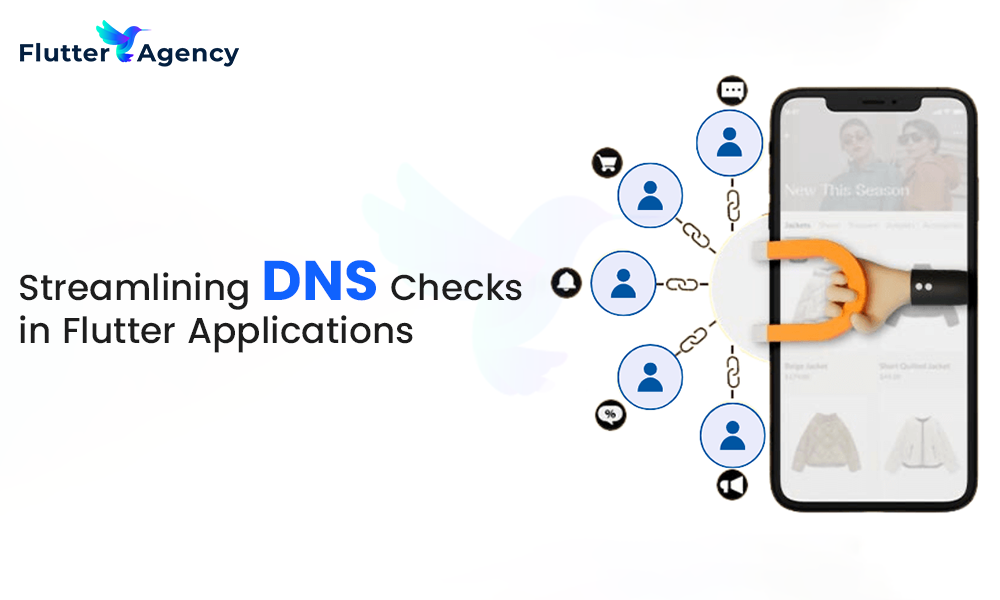Streamlining DNS Checks in Flutter Apps
Mobile applications’ fast and reliable performance is essential in today’s digital world. The Domain Name System is the main component of this performance (DNS). This article will explain DNS in simple terms, emphasizing its importance and offering tips on making DNS checks in Flutter apps as efficient as possible. This guide can help you with any question you may have about DNS meaning or optimizing the performance of your Flutter app. If you hire Flutter development team, you can focus on your core business objectives while ensuring that your app’s DNS performance remains optimized for a seamless user experience.
What is DNS?
Internet navigation is made more accessible by the Domain Name System (DNS), a decentralized, hierarchical system that converts easily navigable domain names (like example.com) into IP addresses. DNS acts as the internet’s phone book, enabling devices to locate and access servers or webpages without memorizing lengthy, complicated IP addresses.
The DNS works behind the scenes for the matching IP address when a user types a domain name into a browser. This translation is essential because computers and servers require IP addresses to communicate, whereas names are easy for humans to remember.
As developers develop and improve mobile application development, they must have a fundamental understanding of DNS. For a seamless user experience, an efficient DNS lookup ensures that the application connects to the target server swiftly.
The Domain Name System’s Components
The Domain Name System (DNS) is a multi-layered, technical architecture created to translate easily navigable domain names into IP addresses, enabling internet communication. The DNS is made up of a few essential parts that are all crucial to the domain resolution process at massive:
Domain names: It is having the readable addresses humans use to access websites, such as example.com. They offer a solution to remembering IP addresses for accessing web content.
Name servers: These servers convert domain names into IP addresses and store DNS info. Each domain has at least one name server connected to it that keeps track of its information.
Resolvers: Usually offered by ISPs, resolvers store the answers to DNS queries in the cache. The resolver first determines whether it has the IP address cached when a user requests a domain. If not, it raises an inquiry to the appropriate name server.
Registries: These organizations oversee TLDs, such as.com and.org. Registries maintain records of which name servers are in charge of a particular domain.
Registrars: Organizations from whom consumers can buy domain names. After registering a domain, the registrar contacts the registry to ensure the name servers are correctly configured.
DNS Records: These records, kept in name servers, include details about a domain, such as the IP address, mail servers, and name servers connected to it.
DNS Name Server Role
Domain Name System (DNS) name servers are vital components of the DNS. Their responsibilities include managing the translation of domain names into IP addresses and keeping up the data related to domain names. Upon querying a domain, the name servers guide the request, ensuring the accurate IP address is delivered.
As backups, each domain usually includes secondary name servers and the primary name server, which holds the master copy of its DNS information. Effective communications between these name servers are crucial for mobile app development. This process can be delayed by a mistake, resulting in a name server configuration needing to be corrected. This might lead to slower app replies or issues interacting.
Types of DNS Records
There are many kinds of DNS records in the domain mapping process, each with a specific function. While diagnosing or configuring domain-related issues, app developers must thoroughly understand these records.
- Domain or subdomain pointers to IPv4 addresses are called A Records (Address Records). It’s the most utilized DNS record when directing traffic from a domain to a particular server.
- A domain or subdomain that points to another domain name is called a Canonical Name (CNAME) record. An alias for one name can be created with it.
- Directs mails for a domain to the servers that host its user accounts through MX Records (Mail Exchange). A preference value and a name server are indicated in each MX record.
- Name server records, or NS Records, describe a domain’s authoritative name servers. In simple terms, the name server is an internet server dedicated to answering requests about the locations of the many services associated with a domain name.
- Text-based data is stored as TXT records, frequently used for verification procedures.
Best Practices for Streamlining DNS Lookups
Having stressed the significance, let us examine optimal methods for optimizing DNS requests in Flutter applications.
1. Minimize DNS Lookups
Your application must execute as few DNS lookups as possible. When feasible, merge several requests into one to save time and resources.
2. Implement DNS Caching
Partial IP address and domain name storage can be achieved by using DNS caching. Performance improves as a result of fewer pointless lookups.
3. Select Asynchronous Calls
To offer a flawless user experience, make DNS queries asynchronously to prevent stopping the application’s main thread.
4. Set Reasonable Timeouts
To prevent excessive delays, configure timeouts for DNS requests. A thoughtfully selected timeout will balance response time and dependability.
5. Use LSI Keywords in the Coding
For improved search engine exposure, include LSI (Latent Semantic Indexing) keywords in your code when optimizing your DNS checks in Flutter applications. These keywords enhance the discoverability of your app without hindering the user experience.
Additional Considerations
- Security Implications: Briefly discuss the security implications of DNS lookups and how developers can safeguard their Flutter apps against DNS-related vulnerabilities or attacks.
- Case Studies or Examples: Adding real-world case studies or examples where optimizing DNS lookups significantly improved a Flutter app’s performance could make the article more compelling.
- Cross-Platform Considerations: Since Flutter is a cross-platform framework, discussing any platform-specific DNS considerations (Android vs. iOS) could provide valuable insights to developers.
Conclusion
Streamlining DNS checks in Flutter apps is essential to improving efficiency and providing a seamless user experience. By following the recommended standards and implementing effective DNS caching into location, you can make sure your software runs consistently, loads swiftly, and attracts people repeatedly.
Recall that a robust DNS check system forms the backbone of an efficient Flutter application. So, invest the time and try to do it correctly from the beginning. Hire a Flutter App Development Company Today if You Need Flutter Development Services!
Book Your Flutter Developer Now
Contemporary ventures
Recent blog
ready to get started?
Fill out the form below and we will be in touch soon!
"*" indicates required fields














